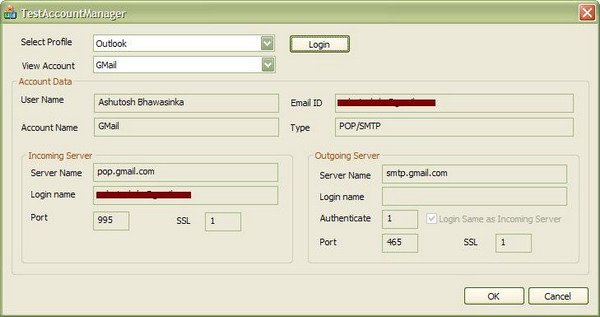
Introduction
This article shows how to use the Account Management APIs to get email accounts configured in Outlook.
Background
The reason for writing this article is that Microsoft didn't provide a header file for the interface used. Moreover, not all the properties of the account are documented by Microsoft.
Using the Code
If you want to skip the technical details and just want to use the feature, follow these steps:
- Add these files in your project:
- AccountData.h - Contains class to hold the account data
- AccountHelper.h - Contains declaration of class
CAccountHelper - AccountHelper.cpp - Implementation of class
CAccountHelper - AcctMgmt.h - Contains the CLSID/IID and the property tags declaration
- AcctMgmt.cpp - Contains the code which actually extracts the account data
- Configure your project to link mapi32.lib
- Include the file AccountHelper.h in your *.h or *.cpp file
- Call
GetAccounts passing it the Outlook profile name as shown below:
TCHAR szProfile[] = _T("ProfileName"); AccountData *pAccountData = NULL; DWORD cAccountData = 0;
if(FAILED(GetAccounts(szProfile, &cAccountData, &pAccountData)))
{
AfxMessageBox(_T("Failed to get account data"));
return;
}
else
{
for(DWORD i = 0 ; i <cAccountData; i++)
{
_tprintf(_T("Is Exchange account : %d"),pAccountData[i].lIsExchange);
_tprintf(_T("Email ID is : %s"),pAccountData[i].szEmailID);
_tprintf(_T("Incoming Server (POP/IMAP) is : %s"),
pAccountData[i].szIncomingServer);
_tprintf(_T("Outgoing Server is : %s"),pAccountData[i].szOutgoingServer);
_tprintf(_T("Account Stamp : %s"),pAccountData[i].szAccountStamp);
}
}
Inside the Hood
If you want to implement this yourself, you need to do these things:
- First implement this interface
IOlkAccountHelper. Let's assume that the class name is CAccountHelper - Login to MAPI, store the profile name in a variable. You will need it to pass back to MAPI in the class
CAccountHelper - Create an instance of
IID_IOlkAccountManager - Create an object of the class
CAccountHelper - Call the
IOlkAccountManager:Init passing the CAccountHelper object you created - Call
IOlkAccountManager::EnumerateAccounts to get an interface to IOlkEnum - Call
IOlkEnum::GetCount to get the accounts count - Call
IOlkEnum::Reset - In a loop, call
IOlkEnum::GetNext to retrieve all the accounts
The code for GetAccount which actually does these looks like this:
HRESULT GetAccounts(LPWSTR lpwszProfile, DWORD* pcAccounts, AccountData** ppAccounts)
{
HRESULT hRes = S_OK;
LPMAPISESSION lpSession;
LPOLKACCOUNTMANAGER lpAcctMgr = NULL;
hRes = MAPILogonEx(0,
(LPTSTR)lpwszProfile,
NULL,
fMapiUnicode | MAPI_EXTENDED | MAPI_EXPLICIT_PROFILE |
MAPI_NEW_SESSION | MAPI_NO_MAIL | MAPI_LOGON_UI,
&lpSession);
if(FAILED(hRes))
{
AfxMessageBox(L"Failed to login to the selected profile");
}
hRes = CoCreateInstance(CLSID_OlkAccountManager,
NULL,
CLSCTX_INPROC_SERVER,
IID_IOlkAccountManager,
(LPVOID*)&lpAcctMgr);
if(SUCCEEDED(hRes) && lpAcctMgr)
{
CAccountHelper* pMyAcctHelper = new CAccountHelper(lpwszProfile, lpSession);
if(pMyAcctHelper)
{
LPOLKACCOUNTHELPER lpAcctHelper = NULL;
hRes = pMyAcctHelper->QueryInterface
(IID_IOlkAccountHelper, (LPVOID*)&lpAcctHelper);
if(SUCCEEDED(hRes) && lpAcctHelper)
{
hRes = lpAcctMgr->Init(lpAcctHelper, ACCT_INIT_NOSYNCH_MAPI_ACCTS);
if(SUCCEEDED(hRes))
{
LPOLKENUM lpAcctEnum = NULL;
hRes = lpAcctMgr->EnumerateAccounts(&CLSID_OlkMail,
NULL,
OLK_ACCOUNT_NO_FLAGS,
&lpAcctEnum);
if(SUCCEEDED(hRes) && lpAcctEnum)
{
DWORD cAccounts = 0;
hRes = lpAcctEnum->GetCount(&cAccounts);
if(SUCCEEDED(hRes) && cAccounts)
{
AccountData* pAccounts = new AccountData[cAccounts];
hRes = lpAcctEnum->Reset();
if(SUCCEEDED(hRes))
{
DWORD i = 0;
for (i = 0; i < cAccounts; i++)
{
LPUNKNOWN lpUnk = NULL;
hRes = lpAcctEnum->GetNext(&lpUnk);
if(SUCCEEDED(hRes) && lpUnk)
{
LPOLKACCOUNT lpAccount = NULL;
hRes = lpUnk->QueryInterface(IID_IOlkAccount,
(LPVOID*)&lpAccount);
if(SUCCEEDED(hRes) && lpAccount)
{
ACCT_VARIANT pProp = {0};
HRESULT hRes = S_OK;
hRes = lpAccount->GetProp
(PROP_ACCT_ID, &pProp);
if(SUCCEEDED(hRes) && pProp.Val.dw)
{
pAccounts[i].lAccountID = pProp.Val.dw;
}
hRes = lpAccount->GetProp(PROP_ACCT_NAME,
&pProp);
if(SUCCEEDED(hRes) && pProp.Val.pwsz)
{
pAccounts[i].szAccountName =
pProp.Val.pwsz;
}
hRes = lpAccount->GetProp
(PROP_ACCT_IS_EXCH, &pProp);
if(SUCCEEDED(hRes) && pProp.Val.dw)
{
pAccounts[i].lIsExchange = pProp.Val.dw;
}
else
{
pAccounts[i].lIsExchange = 0;
}
hRes = lpAccount->GetProp
(PROP_ACCT_SEND_STAMP, &pProp);
if(SUCCEEDED(hRes) && pProp.Val.pwsz)
{
pAccounts[i].szSendStamp = pProp.Val.pwsz;
lpAccount->FreeMemory
((LPBYTE)pProp.Val.pwsz);
}
}
if(lpAccount)
lpAccount->Release();
lpAccount = NULL;
}
if(lpUnk)
lpUnk->Release();
lpUnk = NULL;
}
*pcAccounts = cAccounts;
*ppAccounts = pAccounts;
}
}
}
if(lpAcctEnum)
lpAcctEnum->Release();
}
}
if(lpAcctHelper)
lpAcctHelper->Release();
}
if(pMyAcctHelper)
pMyAcctHelper->Release();
}
if(lpAcctMgr)
lpAcctMgr->Release();
lpSession->Logoff(0,0,0);
lpSession->Release();
return hRes;
}
In the demo application, I have added two buttons "Show Account Dialog" & "Show Add Account Wizard".
The new method added to the interface has this signature:
HRESULT IOlkAccountManager::DisplayAccountList (
HWND hwnd,
DWORD dwFlags,
LPCWSTR lpwszReserved,
DWORD dwReserved,
const CLSID * pclsidReserved1,
const CLSID * pclsidReserved2
);
To use this, I have added this code when the above mentioned buttons are clicked:
LPOLKACCOUNTMANAGER lpAcctMgr = NULL;
hRes = CoCreateInstance(CLSID_OlkAccountManager,
NULL,
CLSCTX_INPROC_SERVER,
IID_IOlkAccountManager,
(LPVOID*)&lpAcctMgr);
if(SUCCEEDED(hRes) && lpAcctMgr)
{
CAccountHelper* pMyAcctHelper = new CAccountHelper(szProfileName, lpSession);
if(pMyAcctHelper)
{
LPOLKACCOUNTHELPER lpAcctHelper = NULL;
hRes = pMyAcctHelper->QueryInterface(IID_IOlkAccountHelper,
(LPVOID*)&lpAcctHelper);
if(SUCCEEDED(hRes) && lpAcctHelper)
{
hRes = lpAcctMgr->Init(lpAcctHelper, ACCT_INIT_NOSYNCH_MAPI_ACCTS);
if(SUCCEEDED(hRes))
{
hRes = lpAcctMgr->DisplayAccountList(this->m_hWnd,dwFlags,0,0,0,0);
if(hRes == MAPI_E_INVALID_PARAMETER)
{
AfxMessageBox(L"dwReserved, pclsidReserved1 or
pclsidReserved2 were non-NULL.");
}
else if(hRes == E_ACCT_UI_BUSY)
{
AfxMessageBox(L"The account dialog class could not be created.");
}
else if( hRes == MAPI_E_USER_CANCEL)
{
AfxMessageBox(L"The Account Settings dialog box returned an error.");
}
else if(hRes == MAPI_E_CALL_FAILED)
{
AfxMessageBox(L"The Add New E-Mail property sheet
returned an error.");
}
}
else
{
AfxMessageBox(L"Failed to initialize IOlkAccountManager");
}
lpAcctHelper>Release();
}
else
{
AfxMessageBox(L"Failed to get Account Helper interface");
}
pMyAcctHelper->Release();
}
else
{
AfxMessageBox(L"Oops!!! Out of memory");
}
lpAcctMgr->Release();
}
else
{
AfxMessageBox(L"Ohhhhhhh No!!! failed to get IOlkAccountManager interface");
}
Special Handling of Exchange Account
Exchange accounts don't have an incoming or outgoing server. Also the email ID for the exchange account is not in the normal form we see to like. To get mailbox server or email ID of the exchange account, you need to open the Global profile section of the profile.
The mailbox server name is stored in the property tag:
PR_INTERNET_CONTENT_ID PROP_TAG(PT_UNICODE, 0x662A)
The email ID is in general stored in these property tags:
PROP_EXCHANGE_EMAILID PROP_TAG(PT_UNICODE, 0x663D)
PROP_EXCHANGE_EMAILID2 PROP_TAG(PT_UNICODE, 0x6641)
In some exchange 2000 accounts, you won't find these properties. In that case, you have to get the IMailUse interface of the user, then query for PR_SMTP_ADDRESS property.
References
For further reading, you may refer to Account Management API Reference.
History
- 4th July, 2008: Initial version
- 27th August, 2008: Article updated
